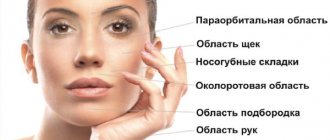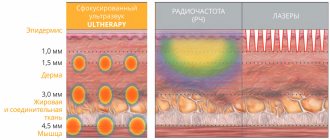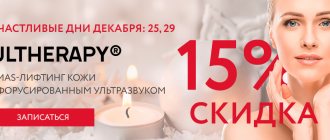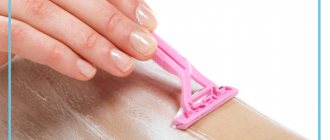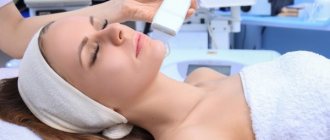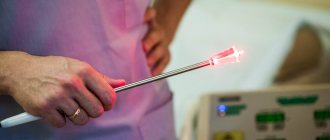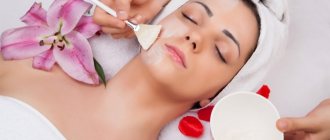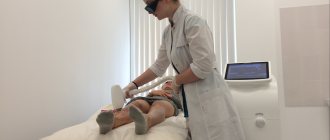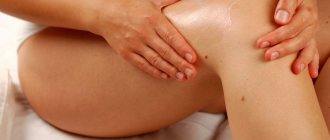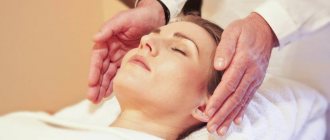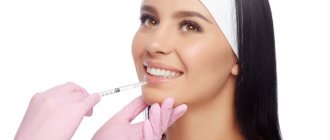Plasma therapy is the injection of the patient’s own purified plasma under the skin. Several injections are made throughout the treatment area so that the distribution of plasma in the problem area is as uniform as possible. The procedure has a very beneficial effect on the skin, the main effect is stimulation of skin fibroblasts and the production of elastin and collagen. Visually, the skin tightens after a course of injections, becomes glowing and youthful in appearance.
Plasma, processed in a special way, contains a large number of platelets, which greatly activate metabolic processes in the place where they are injected. The complex effect of plasma therapy is the launch of self-rejuvenation from the inside. For this, the patient’s body’s own liquid, the “native” plasma, is used, so no rejection or allergy reaction occurs at the injection site.
Quite often, during plasma therapy, a course of injections of hyaluronic acid is simultaneously carried out, which restores the youthful volume of the skin, normalizes its moisture and stimulates the production of collagen and elastin. In addition, microneedle injections have a stimulating effect on the process of tissue regeneration.
Plasma therapy can be performed not only on the face, but also on many other parts of the body (hips, buttocks, chest, arms, etc.). It allows you to tighten weakened and sagging skin and smooth out cellulite. Sometimes plasma injections are used to relieve excessive dryness of the genitals.
This method of rejuvenation not only gives a well-defined cosmetic effect, but also does not cause severe trauma and does not require long and complex rehabilitation. Patients can very quickly return to a normal lifestyle and usual activities.
Effect of plasma therapy
During experiments, scientists discovered that platelet autoplasma has the effect of an “elixir of youth.” When introduced into the skin, it stimulates the production of elastin and collagen, normalizes the supply of oxygen to tissues, makes the skin more moisture-filled, etc. All these effects do not remain visually invisible - the skin tightens, becomes elastic and moisturized, wrinkles are smoothed out.
Plasma therapy increases the local immunity of the skin, which has a beneficial effect on pustular and inflammatory diseases. In addition, there is a powerful stimulation of the regeneration of damaged tissue, so plasma therapy is sometimes used to accelerate the healing of skin damage.
Plasma therapy is used not only on the skin, but also on the mucous membranes. A very rapid tissue response is observed on the mucous membranes. But even in the skin, the very first effect (tissue response) is observed within two hours after injection. However, it takes time for collagen and elastin to grow, so the main effect appears after 1-2 weeks and then increases for some time. The effect of plasma therapy lasts from six months to a year, and sometimes more.
The greatest effect is observed in tissues directly in contact with the injection site (injection point). An important rule of the procedure is to completely “envelop” the entire area of tissue to be treated with plasma therapy. There should be no gaps.
Benefits of PRP Therapy
Plasma injection is especially effective in combating the first signs of facial skin aging. The technique reduces wrinkles, bags and bruises under the eyes, makes expression wrinkles on the forehead and around the lips less noticeable, improves complexion, relieves dry skin, increases its elasticity and tone. The procedure is effective for eliminating scars and acne scars, making them less noticeable. Due to the fact that PRP therapy increases the skin's own immunity, new rashes will not appear.
Having the widest possible capabilities, PRP therapy can not only rejuvenate the skin, but also helps restore the skin and enhance the effect after other cosmetic procedures.
PRP therapy is effective not only for improving the condition of facial skin and its rejuvenation, the technique can improve the condition of the skin in various parts of the body, as well as stop the process of hair loss, making it thicker and more beautiful. The technique effectively rejuvenates the skin of the hands, neck and décolleté, moisturizes and makes it more elastic, and eliminates stretch marks that appeared after lactation. PRP therapy will also help restore elasticity and improve the condition of the skin on the abdomen and thighs if there are stretch marks.
The difference between plasma therapy and PRP therapy
Plasma therapy and PRP therapy are procedures with the same principle of action, but slightly different in the material used. Their effect is also somewhat different. The main difference is the density of platelet concentration per microliter. processed plasma. For plasma therapy, plasma containing 200 - 4000 thousand platelets per μl is prepared, and for PRP therapy, plasma containing 1,000,000 platelets per μl is used.
Well, there are slight differences in the frequency of injections in the course - with plasma therapy they are given more often and the number per course is greater. The average standard course of plasma therapy includes 4 sessions with a frequency of 7-10 days (to maintain the result, 2 courses are done per year), and the standard average course of PRP therapy includes 3 sessions with a month interval between them (to maintain the result, the course is repeated once a year) .
PRP therapy in Krasnodar
An effective PRP therapy technique is presented at the Symmetry cosmetology clinic. Innovative equipment, high-quality certified materials, experienced specialists - all this is a guarantee of high-quality results. In addition, in our clinic the procedure is carried out exclusively under sterile conditions.
At the Symmetry clinic, the cost of PRP therapy procedures is one of the most affordable in Krasnodar. You can learn more about the method of conducting PRP therapy by scheduling a consultation with our specialists in any way convenient for you: by phone or using the feedback form. More information about the cost of PRP therapy in our clinic can be found in the Cost of Services section.
What forms of plasma are used?
The native form is autologous plasma prepared using classical centrifugation technology. It is used most often in cosmetology practice. This plasma restores the water balance in the skin, reduces age-related changes and activates regeneration. This is the most biologically stimulating form of plasma.
Fibrin form of autologous plasma - heated at a temperature of 56C. As a result, fibrinogen irreversibly clots. The resulting fibrin form is a specific mesh matrix on which monocytes, fibroblasts and other cells accumulate, which activate collagen production. Fibroblasts attracted and accumulated on the injected fibrin significantly increase skin turgor and thicken it.
The gel form of autologous plasma is heated in a thermostat for 10 minutes to a temperature of 75-80 C. This plasma is injected into the deep layers of the dermis. It has the strongest effect of strengthening the skin by stimulating the formation of collagen and elastin fibers and best corrects age-related deformational changes. After administration, a lifting effect is observed that increases over several weeks.
How does PRP work?
The operating principle of PRP is based on the properties of platelet cells containing growth factors (biologically active substances that stimulate cell growth and reproduction, protein production).
It is growth factors that stimulate tissue renewal. As a result, the following effects can be observed:
- improving blood supply to tissues;
- activation of local immunity;
- increased production of collagen fibers and fibroblasts.
Regeneration in tissues accelerates, the endometrium thickens, and its structure returns to normal.
How to prepare for the procedure
The first stage is a consultation with a doctor to determine the presence or absence of contraindications to plasma therapy. The doctor will prescribe a series of tests, which include a blood test, a biochemical blood test, and tests for hepatitis and HIV. If it is confirmed that there are no contraindications, then a week before the procedure you should stop peeling the areas to be treated and stop taking all medications (consult your doctor on this topic). Three hours before the session it is not recommended to have a heavy lunch or overeat.
Indications and contraindications for PRP therapy
PRP therapy is indicated in the following cases: - Fading, sagging skin that has lost its firmness and elasticity; — Wrinkles, small scars; — Dry skin, peeling; — Acne, acne and post-acne; - Hyperpigmentation; — Consequences of excessive tanning; — Cellulite, stretch marks; — Skin restoration after laser or chemical peeling; - Hair loss.
Contraindications to the procedure: - Blood diseases; — Chronic diseases of the heart, liver and kidneys; - Oncological diseases; - Allergic reaction; — Pregnancy and lactation period.
How does the plasma therapy procedure work?
The patient comes into the office and lies down on the couch. The cosmetologist cleanses the skin of the face and applies a special anesthetic gel to numb the injections. Then, the doctor takes blood from the patient’s vein (8-36 ml) and immediately places the tube with it in a centrifuge. After 10-15 minutes of blood being in the centrifuge, plasma is separated. During this time, the anesthetic gel has time to take effect. The doctor immediately draws the plasma into a syringe with a thin needle and begins to inject evenly throughout the area to be treated. The procedure takes 45-60 minutes. After this, the doctor treats the skin with a disinfectant, soothing and wound-healing composition.
What is PRP therapy?
PRP therapy is an invasive cosmetic procedure that involves the use of the patient’s own plasma to eliminate various external blemishes of the skin of the face and body.
Blood plasma contains a high concentration of platelets, which transport protein compounds into tissues, improves metabolism, activates the synthesis of its own collagen and elastin, promotes the activation of cellular metabolic processes and the production of natural hyaluronic acid.
Renewed cells stimulate the appearance of new cells, thereby improving skin tone, eliminating small and medium wrinkles, giving a lifting effect.
The main feature of the PRP therapy technique is to improve the condition of the skin by stimulating its own immune and regenerative functions, and not by introducing foreign substances under the skin. Due to this, the occurrence of allergic reactions or side effects is almost impossible. Using the patient's own blood eliminates the possibility of infection.
Rehabilitation
Mild pain and swelling of the treated tissues, which disappear completely after three days, are considered normal manifestations during the recovery period. To prevent complications, you need to avoid skin infection and sunburn, irritation from cosmetics or overheating in the bath.
Within two weeks after the session, the skin is completely restored, but since plasma therapy is carried out in courses with an interval of 7-10 days, the entire period between procedures and 14 days after the final session must adhere to some restrictions and rules in caring for damaged skin.
You should not use any cosmetics other than those prescribed by your doctor. It is forbidden to touch or scratch your face, as this will cause infection in the wounds. You should not sunbathe or visit a solarium, and when going outside you should use sunscreen or a wide-brimmed hat. Also, it is prohibited to visit the bathhouse and sauna. It is not recommended to drink alcohol, as it affects blood flow and the rate of skin regeneration. When choosing a sunscreen and regenerating cream, you should definitely consult your doctor.
Who should not undergo PRP plasma treatment?
The technique is safe, which is why it attracts the attention of orthopedists, traumatologists, cosmetologists, and clinicians. There are no absolute contraindications to it. Contraindications to PRP therapy are relative, that is, those that can be eliminated and the prescribed treatment carried out.
The procedure should be used with caution in the following cases:
- low platelet count in the patient (thrombocytopenia, when there are less than 100 thousand in 1 μl of blood);
- abnormalities in the structure of platelets - thrombocytopathies (there are congenital and acquired, for example, due to vitamin deficiency);
- anemia, moderate and severe anemia, hemoglobin below 90 g/l;
- treatment with drugs that interfere with blood clotting (prescribed for serious heart problems);
- acute infectious inflammation in the joint area or systemic infection (flu, acute respiratory infections, COVID-19, pneumonia, etc.);
- oncological diseases;
- the body's reaction to the anticoagulants used;
- pregnancy.
As you can see, most of the listed contraindications to PRP can be corrected: cure the infection, replenish hemoglobin levels, take vitamins, etc.
Expected effect of plasma therapy
- The skin becomes elastic and fresh.
- Small wrinkles disappear.
- The complexion becomes more even.
- Pigment spots from tanning fade.
- The oval of the face is tightened.
- Scars on the skin are smoothed out a little.
- Sebum secretion is stabilized.
- Skin regeneration accelerates after peeling.
Multiple treatments are usually required to achieve the desired level of change. Their number is determined by the doctor depending on how the patient’s tissues respond to plasma therapy. For some people, the results are clearly visible within a couple of days, while for others, only after a couple of months. The degree of effect largely depends on age; at 30 years of age, the changes after plasma therapy are much more significant than at 60, although the quality of the skin improves in any case.
Scars and cicatrices are smoothed out due to the activation of the growth of new young skin structures. The combination of peeling followed by plasma therapy is especially effective for removing scars and post-acne. In this case, peeling cuts off old uneven structures, and plasma therapy stimulates active replacement with new young skin cells.
In any case, remember that the effect of plasma therapy increases gradually as collagen and elastin fibers are formed. They cannot grow in the first few days after the procedure. Therefore, the progressive development of improvements in skin turgor is clearly expressed.
Content:
Modern medical cosmetology offers patients various innovative and effective methods of skin rejuvenation and regeneration. One of these techniques is PRP therapy for the face and body. The procedure, based on the activation of natural recovery processes, has already proven itself on the positive side in a professional environment. Thanks to the PRP therapy procedure, you can make your skin more elastic and hydrated, significantly improve your complexion, and make wrinkles around the eyes and lips less noticeable.
The PRP therapy technique is used not only in cosmetology, but also in medicine. For example, in orthopedics, indications for prescribing the technique include diseases such as arthritis, arthrosis, and osteochondrosis.

